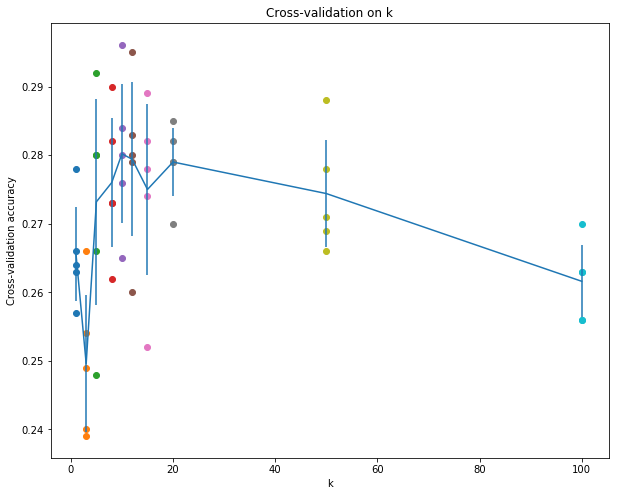斯坦福CS231n專案實戰(一):k最近鄰(kNN)分類演算法
k最近鄰分類(kNN,K Nearest neighbor)分類演算法是一種最簡單的分類器之一。在kNN演算法訓練過程中,它將所有訓練樣本的輸入和輸出label都儲存起來。測試過程中,計算測試樣本與每個訓練樣本的L1或L2距離,選取與測試樣本距離最近的前k個訓練樣本。然後對著k個訓練樣本的label進行投票,票數最多的那一類別即為測試樣本所歸類。
其實,kNN分類演算法非常簡單,可以說在訓練過程中基本沒有演算法,沒有計算過程,kNN分類演算法實際上是一種識記類演算法。但很明顯其包含了以下幾個缺點:
整個訓練過程需要將所有的訓練樣本極其輸出label儲存起來,因此,空間成本很大。
測試過程中,每個測試樣本都需要與所有的訓練樣本進行比較,執行時間成本很大。
對於影象識別問題,根據不同圖片的畫素值進行kNN演算法,一般識別正確率不高,但是整個過程可以瞭解一下。
下面是kNN分類演算法的示例程式碼,所選擇的資料庫是CIFAR10。本文詳細程式碼請見我的:
1. Download the CIFAR10 datasets, and load it
You have two ways to download the CIFAR10 datasets:
cd the path to ‘./CIFAR10/datasets/’, and run the ‘get_datasets.sh’. Then it will automatically download the datasets and decompress it.
Enter the CIFAR10 website: http://www.cs.toronto.edu/~kriz/cifar.html and manually download the python version. Then put the datasets in local folder ‘./CIFAR10/datasets/’.
The CIFAR10 datasets named ‘cifar-10-batches-py/’
Setup code
# Run some setup code for this notebook.
import random
import numpy as Load the CIFAR10 data
# Load the raw CIFAR-10 data.
cifar10_dir = 'CIFAR10/datasets/cifar-10-batches-py'
X_train, y_train, X_test, y_test = load_CIFAR10(cifar10_dir)
# As a sanity check, we print out the size of the training and test data.
print('Training data shape: ', X_train.shape)
print('Training labels shape: ', y_train.shape)
print('Test data shape: ', X_test.shape)
print('Test labels shape: ', y_test.shape)Training data shape: (50000, 32, 32, 3)
Training labels shape: (50000,)
Test data shape: (10000, 32, 32, 3)
Test labels shape: (10000,)
Show some CIFAR10 images
classes = ['plane', 'car', 'bird', 'cat', 'dear', 'dog', 'frog', 'horse', 'ship', 'truck']
num_classes = len(classes)
num_each_class = 7
for y, cls in enumerate(classes):
idxs = np.flatnonzero(y_train == y)
idxs = np.random.choice(idxs, num_each_class, replace=False)
for i, idx in enumerate(idxs):
plt_idx = i * num_classes + (y + 1)
plt.subplot(num_each_class, num_classes, plt_idx)
plt.imshow(X_train[idx].astype('uint8'))
plt.axis('off')
if i == 0:
plt.title(cls)
plt.show()Subsample the data for more efficient code execution
# train numbers
num_train = 5000
mask = range(num_train)
X_train = X_train[mask]
y_train = y_train[mask]
# test numbers
num_test = 500
mask = range(num_test)
X_test = X_test[mask]
y_test = y_test[mask]# change 4D to 2D, like (5000, 32, 32, 3) -> (5000, 3072)
X_train = np.reshape(X_train, (X_train.shape[0], -1))
X_test = np.reshape(X_test, (X_test.shape[0], -1))
print('X_train shape: ', X_train.shape)
print('X_test shape: ', X_test.shape)X_train shape: (5000, 3072)
X_test shape: (500, 3072)
2. Define a K Nearest Neighbor Class
class KNearestNeighbor(object):
"""a KNN classifier with L2 distance"""
def __init__(self):
pass
def train(self, X, y):
"""
Train the classifier. This is just memorizing all the training data.
Inputs:
- X: A numpy array of shape (num_train, D) containing the training data
consisting of num_train samples each of dimension D.
- y: A numpy array of shape (num_train,) containing the training labels,
where y[i] is the label for X[i].
"""
self.X_train = X
self.y_train = y
def predict(self, X, k = 1, num_loops = 0):
"""
Test the classifier.
Inputs:
- X: A numpy array of shape (num_test, D) containing the test data
consisting of num_test samples each of dimension D.
- k: The number of nearest neighbors that vote for the predicted labels.
- num_loops: Determine whether use for-loop to calculate L2 distance
between the train points and test points
Return:
- pred_y: Predict output y
"""
# calculate the L2 distance between test X and train X
if num_loops == 0:
# no for-loop, vectorized
dists = self.cal_dists_no_loop(X)
elif num_loops == 1:
# one for-loop, half-vectorized
dists = self.cal_dists_one_loop(X)
elif num_loops == 2:
# two for-loop, no vectorized
dists = self.cal_dists_two_loop(X)
else:
raise ValueError('Invalid value %d for num_loops' % num_loops)
# predict the labels
num_test = X.shape[0]
y_pred = np.zeros(num_test)
for i in range(num_test):
dists_k_min = np.argsort(dists[i])[:k] # the closest k distance loc
close_y = self.y_train[dists_k_min] # the closest k distance ,all labels
y_pred[i] = np.argmax(np.bincount(close_y)) # [0,3,1,3,3,1] -> 3 as y_pred[i]
return y_pred
def cal_dists_no_loop(self, X):
"""
Calculate the distance with no for-loop
Input:
- X: A numpy array of shape (num_test, D) containing the test data
consisting of num_test samples each of dimension D.
Return:
- dists: The distance between test X and train X
"""
num_test = X.shape[0]
num_train = self.X_train.shape[0]
dists = np.zeros((num_test, num_train))
# (X - X_train)*(X - X_train) = -2X*X_train + X*X + X_train*X_train
d1 = np.multiply(np.dot(X, self.X_train.T), -2) # shape (num_test, num_train)
d2 = np.sum(np.square(X), axis=1, keepdims=True) # shape (num_test, 1)
d3 = np.sum(np.square(self.X_train), axis=1) # shape (1, num_train)
dists = np.sqrt(d1 + d2 + d3)
return dists
def cal_dists_one_loop(self, X):
"""
Calculate the distance with one for-loop
Input:
- X: A numpy array of shape (num_test, D) containing the test data
consisting of num_test samples each of dimension D.
Return:
- dists: The distance between test X and train X
"""
num_test = X.shape[0]
num_train = self.X_train.shape[0]
dists = np.zeros((num_test, num_train))
for i in range(num_test):
dists[i] = np.sqrt(np.sum(np.square(self.X_train - X[i]), axis=1))
return dists
def cal_dists_two_loop(self, X):
"""
Calculate the distance with two for-loop
Input:
- X: A numpy array of shape (num_test, D) containing the test data
consisting of num_test samples each of dimension D.
Return:
- dists: The distance between test X and train X
"""
num_test = X.shape[0]
num_train = self.X_train.shape[0]
dists = np.zeros((num_test, num_train))
for i in range(num_test):
for j in range(num_train):
dists[i][j] = np.sqrt(np.sum(np.square(X[i] - self.X_train[j])))
return dists 3. Train and Test
Create a KNN classifier instance
KNN = KNearestNeighbor()
KNN.train(X_train, y_train)Compare the value of distance_computation by no loop, one-loop and two-loop
dists_no_loop = KNN.cal_dists_no_loop(X_test)
dists_one_loop = KNN.cal_dists_one_loop(X_test)
dists_two_loop = KNN.cal_dists_two_loop(X_test)
diff1 = np.linalg.norm(dists_no_loop - dists_one_loop)
diff2 = np.linalg.norm(dists_no_loop - dists_two_loop)
print('The difference between no-loop and one-loop is: %f' % diff1)
print('The difference between no-loop and two-loop is: %f' % diff2)
if diff1 < 0.001 and diff2 < 0.001:
print('Good, the distance matrices are the same!')
else:
print('Oh, the distance matrices are different')The difference between no-loop and one-loop is: 0.000000
The difference between no-loop and two-loop is: 0.000000
Good, the distance matrices are the same!
Compare the speed of distance_computation by no-loop, one-loop and two-loop
def time_func(f, *args):
"""
Call a function f with args and return the time (in seconds) that it took to execute.
"""
import time
t_st = time.time()
f(*args)
t_ed = time.time()
return t_ed - t_st
# no-loop
no_loop_time = time_func(KNN.cal_dists_no_loop, X_test)
print('No loop time: %f seconds' % no_loop_time)
one_loop_time = time_func(KNN.cal_dists_one_loop, X_test)
print('One loop time: %f seconds' % one_loop_time)
two_loop_time = time_func(KNN.cal_dists_two_loop, X_test)
print('Two loop time: %f seconds' % two_loop_time)
No loop time: 0.185584 seconds
One loop time: 27.167150 seconds
Two loop time: 35.573068 seconds
So the fully vectorized implementation is fastest!
Predict test dataset
# k = 1
y_pred = KNN.predict(X_test, k=1)
num_correct = np.sum(y_pred == y_test)
accuracy = np.mean(y_pred == y_test)
print('Correct %d/%d: The accuracy is %f' % (num_correct, X_test.shape[0], accuracy))Correct 137/500: The accuracy is 0.274000
# k = 5
y_pred = KNN.predict(X_test, k=5)
num_correct = np.sum(y_pred == y_test)
accuracy = np.mean(y_pred == y_test)
print('Correct %d/%d: The accuracy is %f' % (num_correct, X_test.shape[0], accuracy))Correct 139/500: The accuracy is 0.278000
3. Cross Validation
We don’t sure which k value is the best choice. So We will now determine the best value of this hyperparameter with cross-validation.
num_folds = 5 # split the training dataset to 5 parts
k_classes = [1, 3, 5, 8, 10, 12, 15, 20, 50, 100] # all k, determine the best k
# Split up the training data into folds
X_train_folds = []
y_train_folds = []
X_train_folds = np.split(X_train, num_folds)
y_train_folds = np.split(y_train, num_folds)
# A dictionary holding the accuracies for different values of k
k_accuracy = {}
for k in k_classes:
accuracies = []
#knn = KNearestNeighbor()
for i in range(num_folds):
Xtr = np.concatenate(X_train_folds[:i] + X_train_folds[i+1:])
ytr = np.concatenate(y_train_folds[:i] + y_train_folds[i+1:])
Xcv = X_train_folds[i]
ycv = y_train_folds[i]
KNN.train(Xtr, ytr)
ycv_pred = KNN.predict(Xcv, k=k, num_loops=0)
accuracy = np.mean(ycv_pred == ycv)
accuracies.append(accuracy)
k_accuracy[k] = accuracies
# Print the accuracy
for k in k_classes:
for i in range(num_folds):
print('k = %d, fold = %d, accuracy: %f' % (k, i+1, k_accuracy[k][i]))k = 1, fold = 1, accuracy: 0.263000
k = 1, fold = 2, accuracy: 0.257000
k = 1, fold = 3, accuracy: 0.264000
k = 1, fold = 4, accuracy: 0.278000
k = 1, fold = 5, accuracy: 0.266000
k = 3, fold = 1, accuracy: 0.239000
k = 3, fold = 2, accuracy: 0.249000
k = 3, fold = 3, accuracy: 0.240000
k = 3, fold = 4, accuracy: 0.266000
k = 3, fold = 5, accuracy: 0.254000
k = 5, fold = 1, accuracy: 0.248000
k = 5, fold = 2, accuracy: 0.266000
k = 5, fold = 3, accuracy: 0.280000
k = 5, fold = 4, accuracy: 0.292000
k = 5, fold = 5, accuracy: 0.280000
k = 8, fold = 1, accuracy: 0.262000
k = 8, fold = 2, accuracy: 0.282000
k = 8, fold = 3, accuracy: 0.273000
k = 8, fold = 4, accuracy: 0.290000
k = 8, fold = 5, accuracy: 0.273000
k = 10, fold = 1, accuracy: 0.265000
k = 10, fold = 2, accuracy: 0.296000
k = 10, fold = 3, accuracy: 0.276000
k = 10, fold = 4, accuracy: 0.284000
k = 10, fold = 5, accuracy: 0.280000
k = 12, fold = 1, accuracy: 0.260000
k = 12, fold = 2, accuracy: 0.295000
k = 12, fold = 3, accuracy: 0.279000
k = 12, fold = 4, accuracy: 0.283000
k = 12, fold = 5, accuracy: 0.280000
k = 15, fold = 1, accuracy: 0.252000
k = 15, fold = 2, accuracy: 0.289000
k = 15, fold = 3, accuracy: 0.278000
k = 15, fold = 4, accuracy: 0.282000
k = 15, fold = 5, accuracy: 0.274000
k = 20, fold = 1, accuracy: 0.270000
k = 20, fold = 2, accuracy: 0.279000
k = 20, fold = 3, accuracy: 0.279000
k = 20, fold = 4, accuracy: 0.282000
k = 20, fold = 5, accuracy: 0.285000
k = 50, fold = 1, accuracy: 0.271000
k = 50, fold = 2, accuracy: 0.288000
k = 50, fold = 3, accuracy: 0.278000
k = 50, fold = 4, accuracy: 0.269000
k = 50, fold = 5, accuracy: 0.266000
k = 100, fold = 1, accuracy: 0.256000
k = 100, fold = 2, accuracy: 0.270000
k = 100, fold = 3, accuracy: 0.263000
k = 100, fold = 4, accuracy: 0.256000
k = 100, fold = 5, accuracy: 0.263000
# Plot the cross validation
for k in k_classes:
plt.scatter([k] * num_folds, k_accuracy[k])
# plot the trend line with error bars that correspond to standard deviation
accuracies_mean = [np.mean(k_accuracy[k]) for k in k_accuracy]
accuracies_std = [np.std(k_accuracy[k]) for k in k_accuracy]
plt.errorbar(k_classes, accuracies_mean, yerr=accuracies_std)
plt.title('Cross-validation on k')
plt.xlabel('k')
plt.ylabel('Cross-validation accuracy')
plt.show()# Choose the best k
best_k = k_classes[np.argmax(accuracies_mean)]
# Use the best k, and test it on the test data
KNN = KNearestNeighbor()
KNN.train(X_train, y_train)
y_pred = KNN.predict(X_test, k=best_k, num_loops=0)
num_correct = np.sum(y_pred == y_test)
accuracy = np.mean(y_pred == y_test)
print('Correct %d/%d: The accuracy is %f' % (num_correct, X_test.shape[0], accuracy))Correct 141/500: The accuracy is 0.282000
更多AI資源請關注公眾號:紅色石頭的機器學習之路(ID:redstonewill)




